
Farrow and Jackson was a London engineering, manufacturing and distribution company supplying equipment and merchandise to the wines, spirits and aerated beverages trades for more than a century starting in about 1860.

Farrow and Jackson was a London engineering, manufacturing and distribution company supplying equipment and merchandise to the wines, spirits and aerated beverages trades for more than a century starting in about 1860.
The firm's founder, Benjamin Baldry Farrow, was born in 1774 at Diss, Norfolk, and by 1803 was listed in Kent's directory as a “tinplate-worker” at 18, Great Tower-Street, London. [1] Company catalogues and advertising put the date of the establishment of his business at 1778. [2]
On January 22, 1805, Farrow was admitted into the Freedom of the City of London as an “armourer and brazier”. [3] He continued work as a tinplate worker and was so listed in Kent's 1823 directory [4]
He was manufacturing the iron wine bins for which the company would be renowned as early as 1824, and invented a method of building fire-proof buildings, receiving letters patent (No. 5097) for an “Improvement or improvements in buildings, calculated to render them less likely to be destroyed or injured by fire than heretofore” on February 19, 1825. At this time he was known as an ironmonger. [5]
Farrow's establishment was “A Freehold Estate, situate No. 18, Great Tower-street, the corner of Harp-lane; consisting of a shop, with countinghouse, 4 rooms over, and 2 attics. Also No. 1, Harp-lane, in the rear of the above; consisting of a warehouse of 4 floors. Both are let to Mr. Benjamin Farrow, a highly respectable tenant, under an agreement for a lease of 21 years from Lady-day, 1827, at the yearly rent of £70, clear of all deductions.” [6]
Benjamin Farrow had married Mary Algar in September, 1798; they had eight children. The last, Charles, was born in 1815, and he would grow up to take over the family business.
Charles Farrow was twenty-nine in 1844 when his father died. In his turn, he was admitted into the Freedom of the city as an armourer and brazier. He married Ann Hinton, daughter of coal merchant and wharfinger William Samuel Hinton of Southwark in 1846. By 1850, Charles Farrow's trade was described as “ironmonger, wine bin & wine coopers’ tool maker.” [7]
Farrow took part in the Great Exhibition of 1851. His advertisement in the Exhibition Guide shows how his manufacturing and distribution business had branched out, describing him as “Ironmonger, Smith, Brazier, Tinman, and Gas-Fitter; Manufacturer of Machines, Tools, and Utensils for the Wine and Spirit Trade”. [8] At this time he was offering for sale a wide variety of lab equipment, bottling and corking apparatus, cellar lamps and candlesticks, woodworking tools, glass pipettes and India rubber hoses. Farrow presented his bottling and corking machine at the Paris Exposition Universelle in 1855, and his “Patent Elutriator, for Decanting Wine, &c.” [9] at the Royal Society's 1858 Exhibition of Inventions.
Few items from that time can be found marked with Farrow's name. Porcelain labels for wine bins and three types of corkscrew have survived.
The Farrows had three children, two of whom lived to adulthood. Son Charles Hinton Farrow, born in 1848, would join the firm, which was soon to include a partner.
Richard Brooker Jackson was born in 1824 in Hertford, one of twelve children. Jackson worked as a grocer but was an ironmonger - possibly with Farrow - at the time of his marriage to Anna Maria Perkins in 1853. They had seven children; their son Algernon would eventually join the firm.
Jackson's name is first seen in association with Charles Farrow's in an 1860 advertisement for wrought iron wine bins. [10] For the next decade, the firm advertised regularly in London newspapers. Most ads featured their custom wrought iron wine bins. In 1865, they announced an expansion: “FARROW and JACKSON, manufacturers of wrought-iron wine bins, registered cellular bins, machines, tools, and utensils for the wine and spirit trade, beg respectfully to inform their west-end customers and the public that, in addition to their old-established to their premises in Great Tower-street, city, and their factory in Mansell-street, they have opened a branch at No. 8, Haymarket, where they solicit an inspection of cellars fitted with every variety of winebins.” [11] Advertisements in 1867 characterized the business as "Wine and Spirit Merchants' Engineers." In 1869 came an expansion to Paris with an agent at 23, Rue de Pont Neuf, and "every article required for wine, from the press to crush the grapes to the decanting machine for the table." [12]
After the 1875 publication of a 128-page revised and updated catalogue, the newspaper ads ceased until their success at the 1884 London Exhibition. But they were well-enough known that real estate agents would point out the Farrow & Jackson cellar fittings in homes for sale. No less an authority than the renowned Mrs. Isabella Beeton, in her 1879 Housewife's Treasury of Domestic Information, cautioned the Victorian homeowner that “in the wine cellar the patent wine-bin is now a necessity.” She quoted directly from the Farrow & Jackson catalogue, referring to their 1861-patented Cellular Bin and their 1865 patented Exhibit Wine-bin.
While custom wines bins were always their specialty as manufacturers, Farrow and Jackson also catered to wine and spirit merchants who might buy a cask of some alcoholic beverage with a view to retailing the contents. Once a barrel was purchased, they sold a stand to set it on, a gimlet for sampling it, a tool to get the bung out and a tap to replace it, an apparatus to tilt it, and cooper's tools to rebuild it. As to the liquid, they sold a cylinder to pour it in, a hydrometer to test it, bottles to fill with it, bottling machines, corks to keep it in along with machines to cut, brand and insert them, capsules to put over top and capsuling machines to do that job, then labels and label gumming machines. They sold crates in which to ship filled bottles and machines to clean the empties. For a sampling room to entice prospective buyers, they offered decanters, bottle holders, corkscrews, mahogany tasting stands to hold thirty glasses and the glasses to stock it with, and a spittoon to keep the floor clean.
For the Champagne or carbonated water business, all necessary equipment was available. Brewers were supplied with everything from grain shovels to lager beer engines. From Farrow & Jackson one could buy a bread slicer, an ice cream freezer, a tea pot, a newspaper rack, a sausage warmer and a rosewood hammer for chairing meetings.
It is unknown when he joined the company, but in 1880, Charles Hinton Farrow left his father Charles and Richard Brooker Jackson to direct the firm without him. In 1884, Charles Farrow died, and his brothers-in-law William and John Hinton carried on as directors in their capacity as his executors. The management restructured and they retired at the end of 1885. The new partnership consisted of Richard Brooker Jackson, his son Algernon Brooker Jackson, and Algar George Farrow, Charles Farrow's nephew.
Algernon Brooker Jackson had been training from his youth to qualify for his new position. He was educated in Germany and Switzerland as well as at University College, London. He studied theoretical engineering at the University of Hanover and apprenticed with engineering companies for seven years before coming to work at Farrow & Jackson in 1885. He became a member of the Institution of Mechanical Engineers before the end of the century. [13]
The demand for carbonated waters, plain and flavoured, had been increasing through the 1800s. Charles Farrow's 1873 patent dealt with closures for aerated liquids. In 1890 Farrow & Jackson principals were involved in the formation of the Volcanic-Aëration Company (Limited) whose goal was to sell their patented equipment to supply carbonated drinks on draught. [14] Algernon Jackson was named as managing director. Later that year a second company, the North-Western Volcanic-Aëration Company, had been formed and was advertising in the “Agencies and Commissions” columns for agents to call on brewers, chemists, licensed victuallers and grocers in the north and west counties. [15]
Richard Brooker Jackson died in 1891.
The title page of Farrow & Jackson's comprehensive 1894 catalogue describes them as "Manufacturers of Iron Wine Bins, Cellar and Bar Fittings, Bottle Wax, Seals, &c., Aerated Water and Beer Carbonating Machinery, Patent Beer Raising Apparatus, Brewers' and Bottlers' Requisites, &c." It displays their Royal Warrants to supply cellar equipment to Queen Victoria and Prince Albert.
In 1897, Farrow & Jackson became a limited liability company with Algernon Brooker Jackson as managing director.
The 1898 centenary catalogue of Farrow & Jackson Limited fills nearly 200 pages with supplies that now include necessities for catering and for "iced drink sundries." Nine pages are devoted to their specialty, wine bins, which by that time had been supplied to a number or royal households including Buckingham Palace, St James's Palace, Marlborough House, Sandringham House, York House and Clarence House.
In 1902, Farrow & Jackson published "American and Other Iced Drinks" featuring recipes for cocktails and illustrations of the necessary hardware to make them. The 1922 catalogue emphasizes the company's supplying the "Mineral Water, Bottling, Catering, and Hotel and Restaurant Trades".
Algernon Jackson died in 1925. His obituary noted that the firm of Farrow & Jackson “were the first to introduce into this country and bring into general commercial use liquefied carbonic acid gas.” [13]
In 1930, a new company, Farrow & Jackson & Purdy Ltd., was registered to acquire the assets of Farrow & Jackson and to form a Purdy Patent Machinery Company to not only carry on the business but also expand into the manufacture and distribution of “agricultural implements, conveyors, and other machinery” and “chemicals and other preparations.” [16] However, the Farrow & Jackson name was still prominent, as in this 1957 newspaper advertisement: “TAKE CARE OF YOUR WINES by storing in our inexpensive wine bins. Any size or shape made to order, triangular to fit under stairs if necessary. Farrow & Jackson Ltd. Dept R P 41-42 Prescot street, London E1.” [17]
As recently as 1974, journalist and Guardian wine writer John Arlott promoted Farrow & Jackson in his columns, and referred in the present tense to their production of custom wine bins: “The best known racks in this country are those produced by Farrow & Jackson in square, single-bottle openings of metal secured by wooden corner pieces. They are strong and secure and can be slanted or staggered to fit under the stairs or in any asymmetrical recess in the house.” [18]
With two exceptions noted, the patent information is found in the British National Archives. [19]
The awards up to 1896 are listed on the title page of Farrow & Jackson's 1898 catalogue. [2]
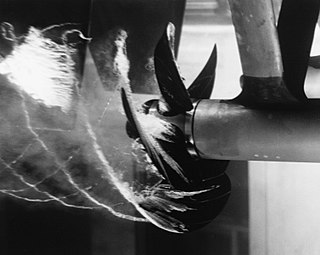
Cavitation in fluid mechanics and engineering normally refers to the phenomenon in which the static pressure of a liquid reduces to below the liquid's vapour pressure, leading to the formation of small vapor-filled cavities in the liquid. When subjected to higher pressure, these cavities, called "bubbles" or "voids", collapse and can generate shock waves that may damage machinery. These shock waves are strong when they are very close to the imploded bubble, but rapidly weaken as they propagate away from the implosion. Cavitation is a significant cause of wear in some engineering contexts. Collapsing voids that implode near to a metal surface cause cyclic stress through repeated implosion. This results in surface fatigue of the metal, causing a type of wear also called "cavitation". The most common examples of this kind of wear are to pump impellers, and bends where a sudden change in the direction of liquid occurs. Cavitation is usually divided into two classes of behavior: inertial cavitation and non-inertial cavitation.
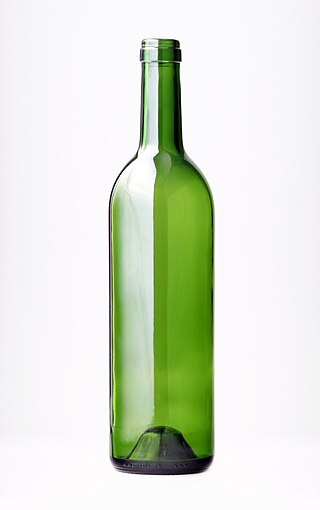
A bottle is a narrow-necked container made of an impermeable material in various shapes and sizes that stores and transports liquids. Its mouth, at the bottling line, can be sealed with an internal stopper, an external bottle cap, a closure, or induction sealing.

Carbonated water is water containing dissolved carbon dioxide gas, either artificially injected under pressure or occurring due to natural geological processes. Carbonation causes small bubbles to form, giving the water an effervescent quality. Common forms include sparkling natural mineral water, club soda, and commercially produced sparkling water.

Boxed wine is a wine sold in "bag-in-box" packaging. Traditionally, this consists of a cardboard box containing a wine filled plastic reservoir. The flow of the wine from the box is controlled by a valve.

A column still, also called a continuous still, patent still or Coffey still, is a variety of still consisting of two columns. Column stills can produce rectified spirit.
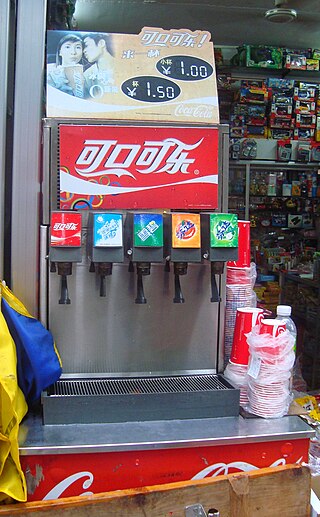
A soda fountain is a device that dispenses carbonated soft drinks, called fountain drinks. They can be found in restaurants, concession stands and other locations such as convenience stores. The artifact combines flavored syrup or syrup concentrate and carbon dioxide with chilled and purified water to make soft drinks, either manually, or in a vending machine which is essentially an automated soda fountain that is operated using a soda gun. Today, the syrup often is pumped from a special container called a bag-in-box (BiB).

A corkscrew is a tool for drawing corks from wine bottles and other household bottles that may be sealed with corks. In its traditional form, a corkscrew simply consists of a pointed metallic helix attached to a handle, which the user screws into the cork and pulls to extract it. Corkscrews are necessary because corks themselves, being small and smooth, are difficult to grip and remove, particularly when inserted fully into an inflexible glass bottle. More recent styles of corkscrew incorporate various systems of levers that further increase the amount of force that can be applied outwards upon the cork, making the extraction of difficult corks easier.
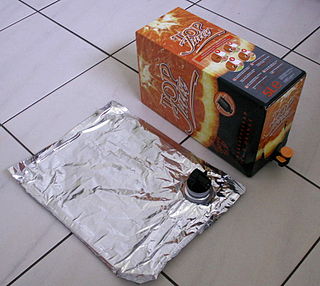
A bag-in-box or BiB is a container for the storage and transportation of liquids. It consists of a strong bladder, usually made of several layers of metallised film or other plastics, seated inside a corrugated fiberboard box.
Wine accessories are things that may be used in the storage or serving of wine. Wine accessories include many items such as wine glasses, corkscrews, and wine racks.
Richard Bowie Spikes was an African-American inventor. The holder of a number of United States patents, his improvements on existing inventions include a beer tap, automobile directional signals, an automatic gear shift device based on automatic transmission for automobiles and other motor vehicles and a safety braking system for trucks and buses.
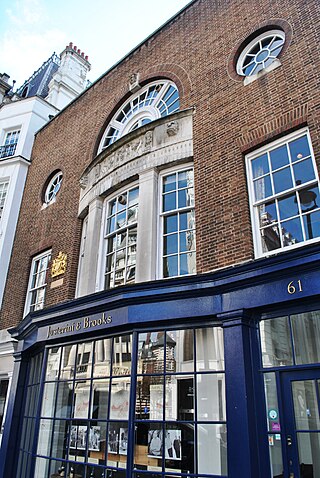
Justerini & Brooks is a fine wine and spirits merchant founded in St. James's in 1749, originally to provide wine and spirits to the aristocratic households of London. The firm has been a supplier to every British monarch since the coronation of King George III in 1761. It sells to private collectors, hotels, and restaurants across the United Kingdom. Justerini & Brooks is owned by multinational Diageo.

Racking, often referred to as Soutirage or Soutirage traditionnel, also filtering or fining, is the process of moving wine or beer from one container to another using gravity rather than a pump, which can be disruptive to the beverage. The process is also known as Abstich in German and travaso in Italian.
Christopher "Kip" Forbes is vice chairman of the Forbes Publishing company.

Storage of wine is an important consideration for wine that is being kept for long-term aging. While most wine is consumed within 24 hours of purchase, fine wines are often set aside for long-term storage. Wine is one of the few commodities that can improve in flavour and value with age, but it can also rapidly deteriorate if kept in inadequate conditions.

Seppeltsfield, one of Australia's oldest wineries, was founded in 1851 by Joseph Ernst Seppelt. The Seppeltsfield winery is well known for its signature wine, the 100-year-old Para Tawny.

The Chaplin's patent distilling apparatus with Steam pump for circulating water attached was an early design of an evaporator, a device for producing fresh water on board ship by distillation of seawater. An example of this apparatus has been recovered from the wreck of SS Xantho (1872), an auxiliary steamship used in Australia to transport passengers and trade goods before ultimately sinking in Port Gregory, Western Australia in 1872. It is purported that the Alexander Chaplin distiller from the Xantho wreck is the only known surviving example of a Chaplin distilling apparatus on board a vessel of this period.
William Hampson (1854–1926) was the first person to patent a process for liquifying air.

A mounted or bar corkscrew is a device screwed or clamped to a wall or counter top, used to draw corks from beer, wine or other bottles.
W. Watson and Son was an optical instrument maker. In 1837, the William Watson business was established in London for the manufacture of optical instruments. By the 1840s, the company moved into lanterns, slides and associated equipment. In 1868, the name was changed to W. Watson & Son and by this time were located at 313 High Holborn, London. In the 1870s, the company added photographic equipment and became known as a leading manufacturer of the Highest Class Photographic Instruments and Apparatus in England. Into the 1940s, the company remained at 313 High Holborn.
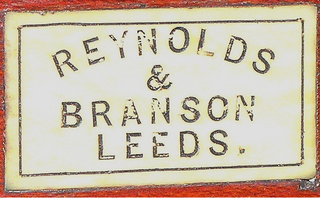
Reynolds & Branson Leeds was a business based at 13 Briggate and 14 Commercial Street in Leeds, England. The business lasted from 1816 to 1972. Edward Matterson managed the company in 1822, and William West F.R.S. took over in 1833. The National Archives Records about the company include a day book, sales ledger, and prescription books. The records were created by Reynolds & Branson Ltd. Reynolds & Branson was registered in July 1898 as a limited corporation with a capital of £34,000 in shares of £10 each by Messrs. R. Reynolds, F. W. Branson. No remuneration was given to Mr. R. Reynolds, but a £700 per annum was given to each of the others. In 1890, Richard Reynold's son, Richard Freshfield (Fred) Reynolds was made a partner. The firm was in the business of wholesale and retail for chemists and surgical instrument makers.